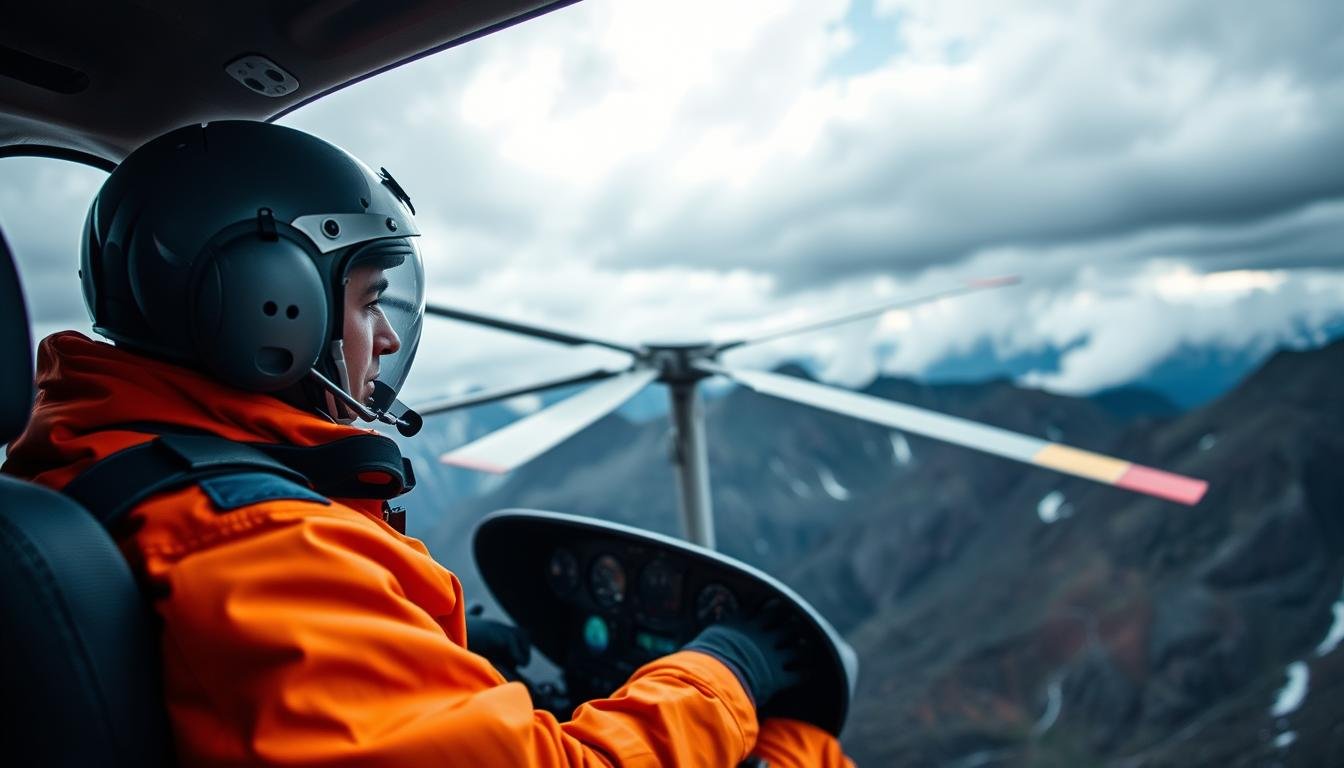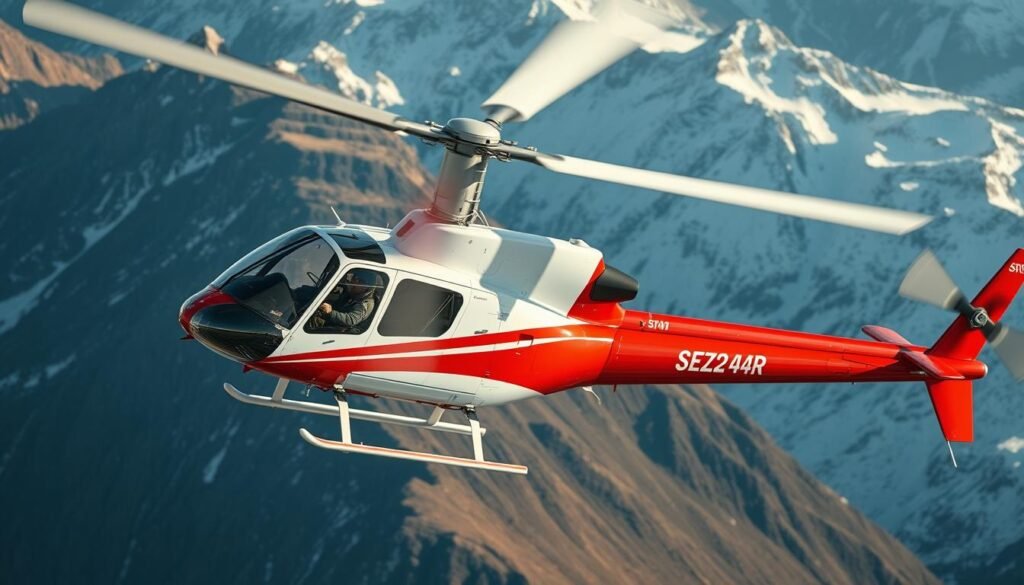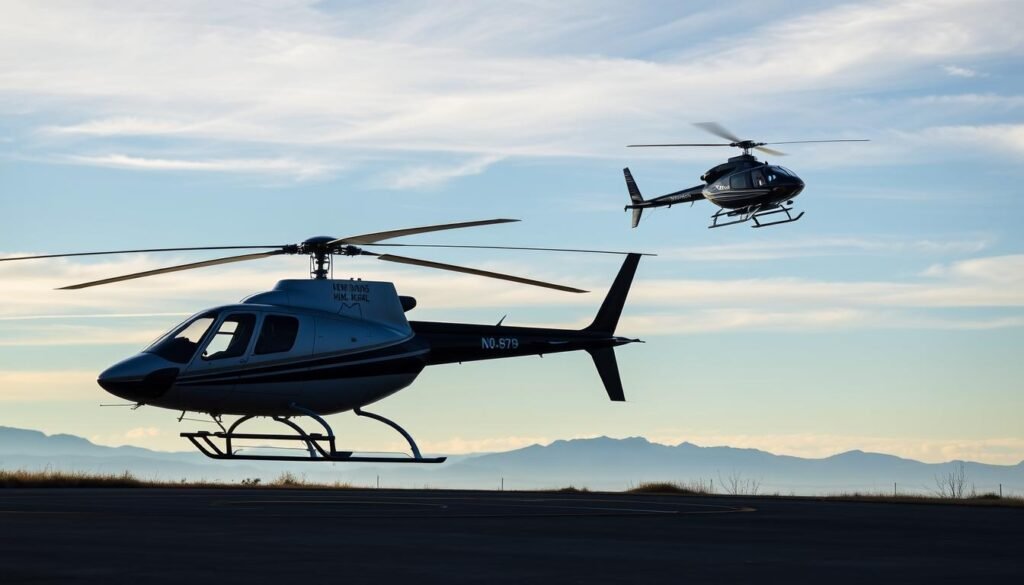One dramatic statistic: after Hurricane Katrina, Coast Guard aircraft helped with 24,135 rescues and evacuated 9,409 hospital patients, showing how critical aerial teams can be.
Search and rescue crews combine range, mobility, precision, and hoisting skill to save lives in remote, damaged, or flooded areas. The pilot leads the mission from first alert to final landing, guiding crew, medics, and ground units.
On any call, minutes matter. The team uses hover control, targeted search patterns, and hoist systems to reach people on land or water. Pilots plan routes, assess risk, and brief crews before committing to a mission.
This role demands rapid decisions, stress management, and ongoing training in instruments, night vision, and hoisting. It also ties into disaster relief and debris-field searches, where pilots have found dozens of survivors that ground teams missed.
Readers who want career context can review pilot salary and experience guidance in this short guide on helicopter pilot career stages.
Key Takeaways
- Pilots lead search rescue missions from alert to landing, coordinating crew and resources.
- They use hover precision and hoist systems to reach stranded people on land and water.
- Success requires rapid decision-making, strong communication, and steady training.
- Helicopter-led searches play a vital role in disaster relief and debris-field rescues.
- The career demands resilience, teamwork, and adherence to strict procedures.
Inside A Day On Call: From First Light To Last Landing
Dawn routines center on aircraft status, forecast updates, and aligning teams for likely tasking.
Gav, who flies the AW139 with Toll Ambulance Rescue Helicopter in Sydney, starts each shift with focused weather checks and an aircraft walkaround. Early briefings with operations map likely search rescue zones and resource needs.
Crew briefings cover roles, hoist readiness, and medical coordination. Midday may include currency flying or short training sorties to keep skills sharp.
Shifts can flip from quiet standby to multiple missions. Quick turnarounds demand refuel stops, kit changes, and tight radio discipline. Teams prioritize operations by urgency and available weather windows.
“Turning down a task because conditions are unsafe stays with you for days,”
Fatigue management matters: structured rest, hydration, and simple mental checks keep performance steady over long hours. Communication with medics and crew shortens time on scene when lives are at risk.
- Early checks and forecasts
- Briefings and preflight workflows
- Training, missions, debriefs, and logs
For context on EMS roles, see the EMS helicopter pilot guide and read about operational challenges faced by crews.
Meet The SAR Crew And The Aircraft They Fly
A tight-knit team and well-configured aircraft turn fast alerts into successful rescues. The base culture Gav describes favors low ego, open questions, and shared experience. That attitude keeps missions safe and learning continuous.
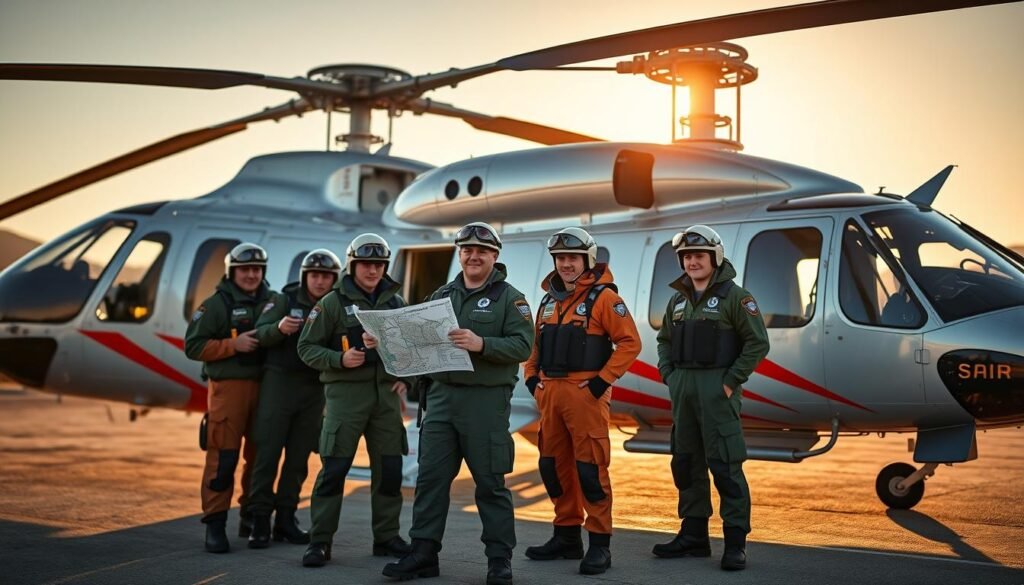
Pilot, Crew Chief, And Medical Team: Roles That Keep Missions Safe
Pilots lead aircraft control and set operational limits. The crew chief manages the winch and cabin safety. Medics provide advanced care during flight. Each role is essential to mission success.
Preflight Planning, Risk Assessment, And Mission Briefs
The team reviews NOTAMs, weather, fuel, terrain, and performance data. Briefs assign duties and contingencies. On-scene checklists and callouts translate that planning into tight coordination during high-risk evolutions.
Hoists, Stretchers, And Survival Gear: What Goes On Board
Fleets like Helicopter Express run AW139-class aircraft fitted with hoists, rescue baskets, litters, and medical monitors. Night vision, comms, and survival kits let teams operate in crosswinds and tough terrain.
- Support teams—maintenance, dispatch, and logistics—keep aircraft ready for back-to-back launches.
- Senior crew mentor newer members in winching, instrument work, and crew resource management.
“Experience shared freely and a no-blame policy make safer outcomes the priority.”
Scramble To Launch: How Missions Begin And Evolve In Real Time
Dispatch fires off a tasking and the crew moves through quick-start checklists to turn readiness into launch in minimal time. Radios come alive; the pilot acknowledges and the team confirms roles, kit, and fuel status.
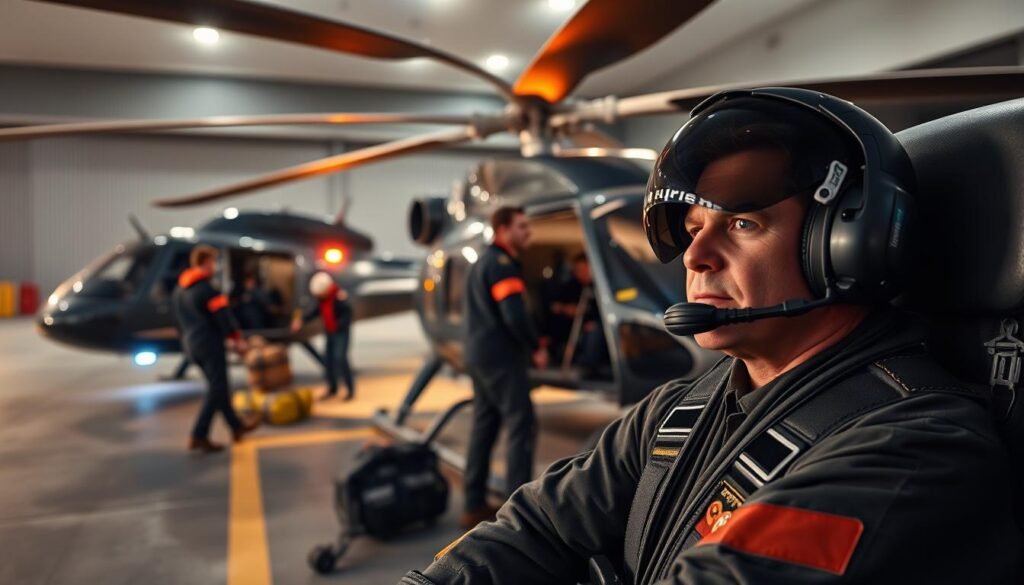
Dispatch, Radio Comms, And Tasking In A Fast-Moving Environment
Dispatch links operations, ATC, ground units, and maritime teams. Short, clear transmissions cut clutter and keep the operational picture current.
Standard callouts and sterile-cockpit windows protect focus during high-tempo phases. That discipline lowers error risk when every second of time matters.
Routing, Fuel, And Weather Windows Over Land And Sea
The pilot plots routing to minimize miles while avoiding restricted airspace and rough terrain. Fuel planning preserves reserves for the mission plus contingencies and possible diversions.
Weather windows drive go-now choices: ceilings, winds, precipitation, and sea state determine legal and safe margins. In flight, updated coordinates, changing patient status, or shifting locations force quick recalculations.
- Crews balance time on station with transit time and fuel to reach a recovery point.
- Real-time coordination sets hover points and adjusts profiles for remote over-water or mountain work.
- Helicopter pilots continually reassess power margins, weight, and density altitude to stay safe.
“Decisive, concise communication underpins safe outcomes when the scene changes midflight.”
Arrival on scene means a rapid shift into hoist or landing procedures and close coordination with rescue teams. Clear comms and strict operations discipline ensure safe handover and mission success.
What Does a SAR Helicopter Pilot Do? Core Missions In The Field
Pilots and crews split large zones into sectors, sweeping each sector with precise passes to reveal small signs of life amid wreckage.
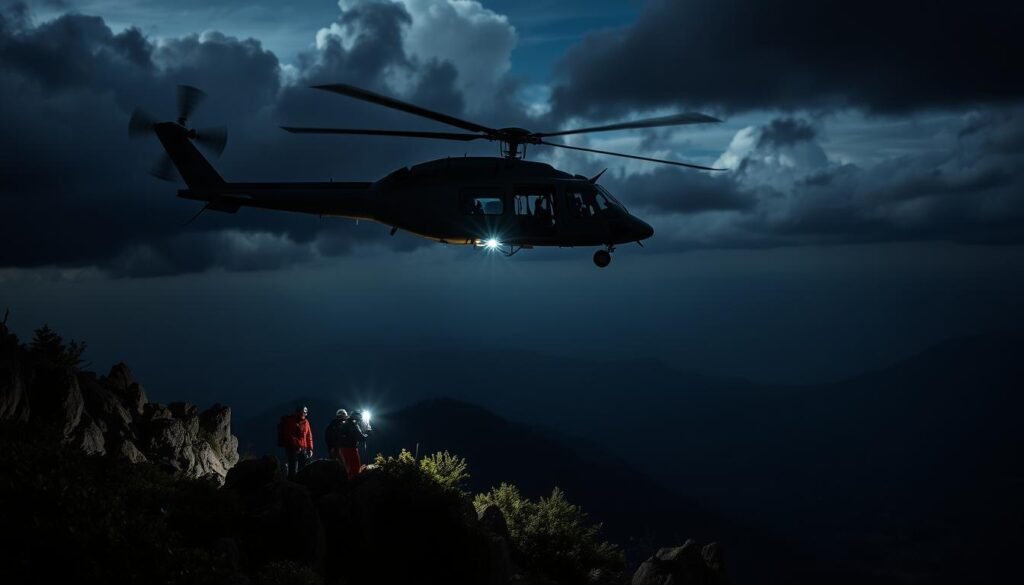
Debris Field Searches After Crashes And Storms
Debris fields are scanned using low-speed flight and careful hover work. Early detection can mean the difference between life and death.
Helicopters excel at close inspection and spotting survivors from above. After Hurricane Dorian one crew found 30–40 people on Little Abaco Island.
Water And Sea-Cliff Rescues In High-Wind, High-Swell Conditions
Over sea and cliffs, hover precision and the hoist are vital. Crews call exact coordinates and winch people quickly when waves and wind threaten survival.
Power margins, spray, and salt corrosion factor into every plan.
Disaster Relief: Food, Water, And Medical Supply Flights
In disaster relief missions, helicopters carry thousands of pounds of aid and medical teams into isolated areas.
They often arrive before roads reopen, giving people urgent help and stabilizing scenes until ground teams arrive.
| Mission Type | Key Tasks | Aircraft Needs | Common Hazards |
|---|---|---|---|
| Debris Field Search | Sector sweeps, spotting, marking survivors | Slow-speed handling, good visibility | Fragmented terrain, confined landing spots |
| Sea/Cliff Rescue | Hover, hoist, coordinated comms | High power margin, corrosion protection | Winds, swell, spray, pilot workload |
| Relief Flight | Load planning, supply drops, med support | Payload capacity, stable hover | Weight balance, limited landing zones |
“A well-directed search pattern cuts wasted time and brings help to those who need it most.”
- Coordination with Coast Guard, EMS, and park services speeds outcomes.
- Pilot choices on search pattern and payload affect survival in cold water and exposed fields.
Decision-Making Under Pressure: Weather, Risk, And The Go/No-Go Call
High-stakes mission calls force crews to weigh clear safety limits against urgent human need.
Teams combine weather reports, terrain briefings, aircraft performance data, and crew readiness to reach a fast, defensible choice. Pilots experienced in rescue work use formal risk tools and decision gates to keep judgment consistent under time pressure.
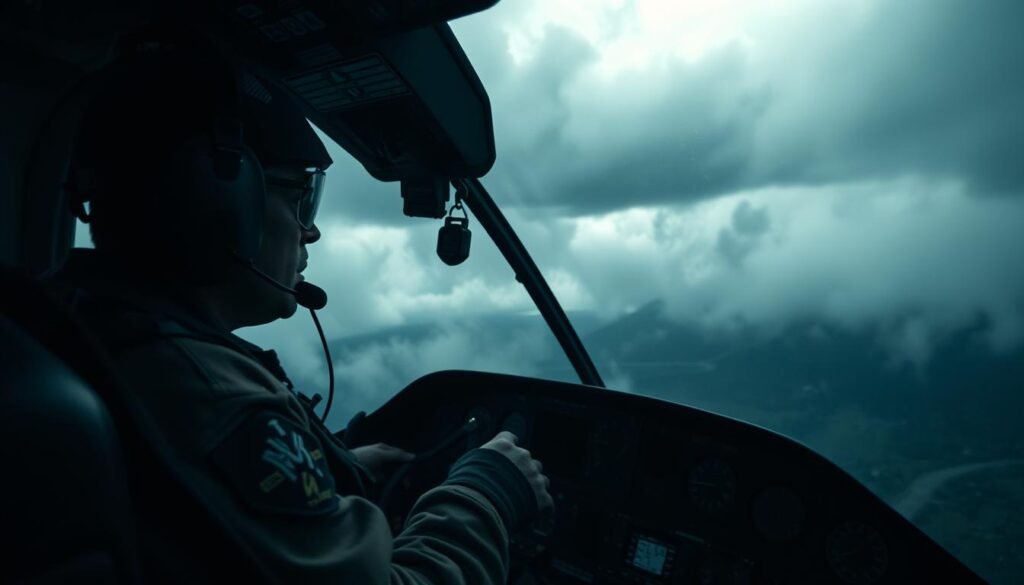
Balancing Crew Safety With Urgent Need In Desperate Situations
He may accept a task conditionally—planning holds, alternates, or equipment changes to reduce exposure.
“Turning down a job because conditions are unsafe stays with you for days,”
Operators set clear abort points for wind, visibility, icing, and sea state that trigger immediate reassessment. Communication matters: concise briefings to dispatch and partner agencies explain why a delay or diversion preserves long-term response capacity.
- Ethical duty: protect crew and patient by following limits.
- Operational tools: risk matrices, weather minima, and diversion criteria.
- Culture: no-blame debriefs and scenario training build pattern recognition.
Disciplined decision-making is itself a life-saving skill. For more on how teams manage marginal conditions, see all-weather operations.
On-Scene Operations: Hoisting, Short-Haul, And Patient Care
On-scene work demands split-second aircraft control and absolute team timing during hoists and short-hauls.
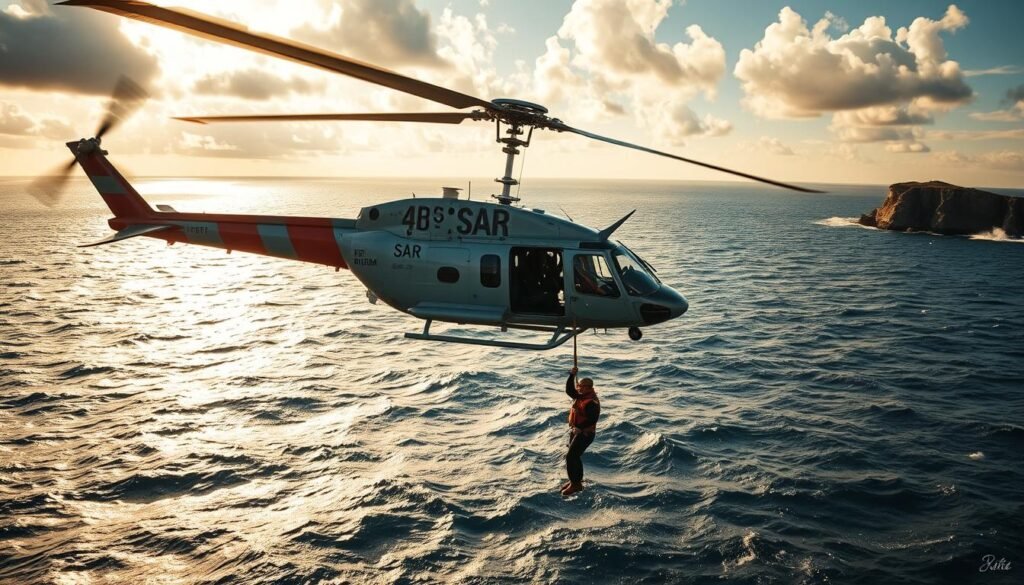
Precision hovering relies on stable visual references, coordinated callouts, and careful power management to control drift over water or cliff faces.
Precision Hovering, Winch Discipline, And Live Human External Loads
Helicopter pilots set hover points using landmarks and instrument cross-checks when contrast is poor, such as calm water or uniform rock faces.
Winch discipline includes defined hand signals, verbal cues, and rehearsed cutaway procedures. These measures keep rescue operations safe when a rescuer or patient is outside the aircraft.
During short-haul work, the pilot balances downwash, line angle, and obstacles to keep the live human external load clear of spray and terrain.
Stabilization In The Aircraft And Rapid Transport To Care
Medical teams begin stabilization as soon as the patient is aboard. The cockpit coordinates cabin environment, altitude, and routing for rapid transport to definitive care.
Contingencies such as sudden wave sets or gust fronts prompt immediate repositioning or alternate routing. Crews rehearse these moves in recurrent check rides and night operations.
“Execution at the scene depends on steady flying, clear calls, and a culture that keeps the cockpit focused.”
- Integration: The pilot, crew chief, and medic work in a sterile-cockpit window during critical phases to avoid distraction.
- Maritime Fit: Helicopters carry flotation gear, rescue baskets, and hypothermia kits and follow corrosion control after saltwater exposure.
- Training: Regular hoist checks, NVG currency, and instrument practice underpin safe rescue operations.
| On-Scene Task | Key Actions | Primary Risk |
|---|---|---|
| Hoist Over Water | Precision hover, winch cues, power reserve | Spray, wave sets, loss of visual cues |
| Short-Haul Load | Line angle control, rotor clearance, crew coordination | Obstacle strike, downwash instability |
| Cabin Stabilization | Immediate medical care, altitude management, fast routing | Delayed transport, uncontrolled environment |
Transfer of care at landing sites or hospitals follows strict handover protocols. Teams record mission data for post-mission review and continuous improvement.
For practical guidance on working with rescue aircraft and safe on-scene procedures, consult this operational guide: working with search and rescue helicopters.
After The Mission: Debriefs, Maintenance, And Mental Health
Post-mission routines mix technical checks, honest debriefs, and time to process what the crew has seen.
Structured debriefs follow a clear, no-blame approach. Teams log lessons, note what worked, and identify gaps that need training or equipment changes.
No-Blame Culture, Lessons Learned, And Continuous Improvement
No-blame debriefs encourage open feedback. The crew captures actionable items and feeds them into training, simulators, and procedures.
Maintenance teams record squawks and return the aircraft to service within hours. That quick turnaround keeps readiness high for the next tasking.
Coping With The Aftermath: Resilience, Counseling, And Peer Support
The human aftermath can be heavy. Tough calls, especially those involving children, may weigh on him for days.
Gav uses exercise, outdoor time, and the GEM model—Gratitude, Empathy, Mindfulness—to process his experience over time.
“Encouraging peers to seek help keeps the team strong.”
- Peer support teams and chaplains offer confidential support.
- Employer-provided counseling gives rapid access to mental health professionals.
- Reflective practice turns real events into safer, smarter work going forward.
| Area | Action | Outcome | Timeframe |
|---|---|---|---|
| Debrief | Open, no-blame review | Documented lessons and training inputs | Within hours |
| Maintenance | Log squawks, test systems | Aircraft returned to service | Hours |
| Mental Health | Peer support, counseling, GEM | Resilience and reduced stigma | Days to weeks |
The pilot’s position includes promoting help and modeling balanced coping. Caring for the crew protects careers and keeps the unit ready to serve the world when needed.
Paths Into The Role: Training, Experience, And U.S. Opportunities
Many routes lead into rescue aviation, from naval flight schools to regional medevac programs.
Candidates can choose military pipelines, Coast Guard tracks, or civilian operators that build mission skills. Each route offers different training and hours toward currency and instrument work.
Military, Coast Guard, And Civilian Routes Into SAR Aviation
Military service and Coast Guard training give structured time-building and complex mission exposure. Prospective candidates in the U.S. can call 1-800-USA-NAVY (Mon–Fri 8:00am–10:00pm CST; Sat–Sun 10:00am–10:00pm) or text NAVYBONUS to 764764 for details (Msg & data rates may apply).
Civilian paths include regional air ambulance, offshore support, and operators that convert experienced pilots into rescue-ready crews. These opportunities help pilots gain over-water and hoist experience fast.
Winching Experience, Night Ops, And Instrument Proficiency
Progression to mission-ready status typically includes instrument ratings, NVG sign-offs, and winch training. Employers expect proven crew resource management, night operations ability, and precise aircraft handling in confined areas.
- Time-building and instrument currency
- Winch and over-water operations
- Mission check rides and NVG sign-offs
Gav’s path—from British Army Apache to air ambulance, offshore winching, then rescue operations—shows how varied experience accelerates readiness. Candidates should seek mentorship, choose locations that match their goals, and join organizations that invest in training and crew support for a sustainable career helicopter pilot position.
Why Helicopters Excel At Search And Rescue Operations
Vertical lift gives rescue teams access to cliff faces and flooded valleys that roads cannot reach. Slow-speed handling and stable hover let crews scan fields and debris closely, then position precisely for hoist or landing.
Hover, Range, And Hoist Capabilities In Hard-To-Reach Locations
Helicopters combine precise hover with robust hoist systems to reach locations unreachable by ground or fixed-wing aircraft. Crews use slow-speed maneuvering to sweep a debris field, mark survivors, and deliver short-haul teams safely.
Range and endurance let aircraft stay on station for hours and cover hundreds of miles, sustaining long rescue operations without constant returns to base.
Operating In Harsh Weather, Over Water, And At High Altitudes
Sea operations demand stable flight in swell and crosswinds; many models operate from ships and handle salt spray with corrosion controls. High-altitude and hot-day performance keep missions viable in mountains and desert canyons.
Integrated sensors, NVGs, and modern comms expand search capability in low light and bad weather, tightening timelines to reach survivors. Fleets range from light utility to medium-lift platforms that carry thousands of pounds of supplies into isolated communities.
Key Advantages
- Precision hover and vertical access for confined landing spots.
- Hours on station and long transit range across coastal and inland locations.
- Maritime capability for over-water rescues and shipboard operations.
- Payload capacity for food, water, and medical supplies after disasters.
| Capability | Operational Benefit | Typical Use |
|---|---|---|
| Hover & Slow-Speed Control | Close inspection, safe hoist positioning | Debris field search, cliff retrieval |
| Range & Endurance | Extended search area, sustained missions | Wide coastal sweeps, multi-site relief |
| Maritime Fit | Stable over water, shipboard ops | Sea rescues, supply runs to vessels |
| Payload & Avionics | Heavy lift and low-light search | Disaster relief, NVG-enabled night ops |
The blend of hover, range, and hoist makes helicopters uniquely suited to complex rescue operations worldwide. For career context on platforms and roles that support these missions, see this guide on best industries for helicopter pilots.
Conclusion
When roads fail and hours count, rotary teams convert readiness into rapid help across harsh terrain. This synthesis shows how pilots, crew, and medics execute search rescue missions that reach people when ground access is impossible.
Helicopter hover and hoist capability turn minutes into saved lives over ocean, mountain, and disaster zones. Disciplined training, risk-based decisions, and a no-blame culture sustain crews through demanding missions.
Opportunities span military, Coast Guard, and civilian paths; aspiring professionals can build hours and experience through volunteering and structured programs. For practical guidance on operational basics and time-building, see this operational primer and tips on how to build flight hours.
The world relies on this unique blend of technology, training, and resolve. Every mission teaches lessons, strengthens teamwork, and keeps people safer next time.
